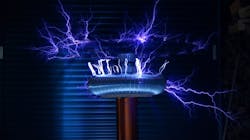Power from the sky: unmanned optical relays may provide on-demand electricity for the battlefield
THE MIL & AERO COMMENTARY – Imaging a future where warfighters on the battlefield can access electricity wirelessly by the kilowatt to power weapons, sensors, and recharge batteries via an aerial power network of unmanned aircraft. That's what military researchers are trying to do with Persistent Optical Wireless Energy Relay (POWER) project.
The U.S. Defense Advanced Research Projects Agency is working with RTX Raytheon in McKinney, Texas (formerly Raytheon Intelligence & Space) on the first phase of the POWER project, which seeks to demonstrate power-beaming optical relays on manned and unmanned aircraft operating within line of sight of military operational areas.
This on-demand power network, if it can be made workable on a relatively large scale, potentially could reduce the need for liquid fuels like jet fuel, gasoline, and diesel fuel, as well as for the military infrastructure necessary to transport and store these vulnerable commodities.
DARPA is just getting started with the POWER project, by awarding a $10 million contract to Raytheon last month for the project's first phase, which seeks to demonstrate optical power-beaming relays as a resilient multipath alternative for expeditionary energy transport, leading to small manned and unmanned aircraft able to provide on-demand power for a wide range of military missions.
First, the POWER project seeks to develop optical technologies to create an airborne relay capable of redirection, wavefront correction, and energy harvesting of optical beams. The project's goal is to demonstrate its potential by using three airborne relay nodes hosted on existing aircraft to transmit as much as 10 kilowatts of energy from a ground source laser to 60,000 feet in altitude, and back down to a ground receiver 125 miles away.
One of the objectives is compensate for atmospheric disturbance that can degrade laser beam quality. To do this, Raytheon engineers will develop a relay able to correct the optical wavefront as needed, and harvest energy from the optical beam to provide on-board auxiliary power.
Overall, the project seeks balance energy generation, storage, and distribution for military missions by capitalizing on power beaming for near-instantaneous energy transport.
Speed-of-light energy transport through a multipath network would enable rapid reconstitution under attack, graceful degradation, and resilience by re-routing energy through the network in a matter of seconds or minutes, and restoring full capability by replacing nodes in minutes or hours.
The POWER program seeks to deliver 10 kilowatts of laser energy to the final ground node using a 50-kilowatt source laser, transmitted through three airborne relay nodes using system apertures smaller than one meter diameter.
In POWER's first phase, Raytheon will develop and mature a relay payload design, and design a relay platform. Later, the program will build a low-power demonstration relay, finally to demonstrate three airborne nodes relaying power to a ground receiver at White Sands Missile Range, N.M., using the High Energy Laser Systems Test Facility (HELSTF), and the RQ-4 Global Hawk large unmanned aircraft as an airborne relay.
It's all a long way from reality, though. Raytheon and any other future POWER contractors are just barely starting a proof of concept, and addressing fundamental enabling technologies that ultimately may or may not pan-out.
Will we see it in our lifetimes? Well, that probably depends on how old you are. Beaming power by laser from a ground transmitter via an unmanned aerial vehicle (UAV) to a receiver on the ground would be only the first step toward crafting a wide-area wireless power network.
Might such an on-demand power network rely only on UAV relays, or might such an approach eventually involve orbiting satellites? The short answer is, it's far too early to tell.
The possibilities certainly are intriguing. What might such a power network mean not only for military operations, but also to help power a growing fleet of private and commercial electric cars and trucks? Does it have the power to render gas stations and storage tanks obsolete? Only time will tell.
About the Author
John Keller
Editor-in-Chief
John Keller is the Editor-in-Chief, Military & Aerospace Electronics Magazine--provides extensive coverage and analysis of enabling electronics and optoelectronic technologies in military, space and commercial aviation applications. John has been a member of the Military & Aerospace Electronics staff since 1989 and chief editor since 1995.
